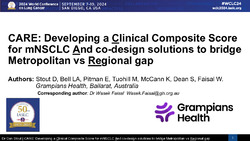Please use this identifier to cite or link to this item:
http://hdl.handle.net/11054/2949Full metadata record
| DC Field | Value | Language |
|---|---|---|
| dc.contributor | Faisal, Wasek | en_US |
| dc.contributor | Stout, Dan | en_US |
| dc.contributor | Pitman, Ethan | en_US |
| dc.contributor | Tuohill, Michael | en_US |
| dc.contributor | McCann, Kathy | en_US |
| dc.contributor | Dean, Sam | en_US |
| dc.contributor | Bell, Lisa | en_US |
| dc.date.accessioned | 2025-01-15T06:20:15Z | - |
| dc.date.available | 2025-01-15T06:20:15Z | - |
| dc.date.issued | 2024 | - |
| dc.identifier.govdoc | 02778 | en_US |
| dc.identifier.uri | http://hdl.handle.net/11054/2949 | - |
| dc.description.abstract | Despite being the fifth most common cancer in Australia, NSCLC-related mortality remains the highest among all cancers with a five-year survival rate of approximately twenty percent. Moreover, there is an absolute difference of six percent in five-year survival between patients from regional/rural areas, compared to metropolitan counterparts. In addition to this geographical difference, the biology of wild-type mNSCLC is extremely varied (e.g. PD-L1, metabolic activity on FDG-PET, tumour differentiation) leading to significantly variable responses to treatment. Developing clinical tools to identify patients upfront with worse tumour biology could aid prognostication and therefore may mitigate the need for over/under treatment. Poorer clinical outcomes in regional patients compared to city patients also highlight the fact that treatment outcomes are not just dependent on tumour factors, but also dependent on patient- and health-service-related factors (e.g. distance to treating centre, delayed referral/diagnosis, guideline non-concordant treatment, lack of clinical trials etc). Thus, through funding by the Thoracic Oncology Group of Australasia (TOGA), we aim to develop a Clinical Composite Score (CCS) encapsulating patient, tumour and health service factors that could help identify patients who are at risk of poorer outcomes, leading to reallocation of resources to develop and implement a co-design solution to address these issues at a system level. | en_US |
| dc.description.provenance | Submitted by Gemma Siemensma (gemmas@bhs.org.au) on 2024-10-23T23:00:48Z No. of bitstreams: 1 CARE project presentation slides.pdf: 267593 bytes, checksum: 74035389dccb5e83973f3746175ff655 (MD5) | en |
| dc.description.provenance | Approved for entry into archive by Gemma Siemensma (gemmas@bhs.org.au) on 2025-01-15T06:20:15Z (GMT) No. of bitstreams: 1 CARE project presentation slides.pdf: 267593 bytes, checksum: 74035389dccb5e83973f3746175ff655 (MD5) | en |
| dc.description.provenance | Made available in DSpace on 2025-01-15T06:20:15Z (GMT). No. of bitstreams: 1 CARE project presentation slides.pdf: 267593 bytes, checksum: 74035389dccb5e83973f3746175ff655 (MD5) Previous issue date: 2024 | en |
| dc.title | Developing a clinical composite score for mNSCLC and co-design solutions to bridge the metropolitan vs regional gap. | en_US |
| dc.type | Conference | en_US |
| dc.type.specified | Presentation | en_US |
| dc.bibliographicCitation.conferencedate | September 7-10 | en_US |
| dc.bibliographicCitation.conferencename | 2024 World Conference on Lung Cancer. | en_US |
| dc.bibliographicCitation.conferenceplace | San Diego, USA | en_US |
| dc.subject.healththesaurus | ONCOLOGY | en_US |
| dc.subject.healththesaurus | CLINICAL TOOL | en_US |
| Appears in Collections: | Research Output | |
Files in This Item:
| File | Description | Size | Format | |
|---|---|---|---|---|
| CARE project presentation slides.pdf | 261.32 kB | Adobe PDF |  View/Open |
Items in DSpace are protected by copyright, with all rights reserved, unless otherwise indicated.
